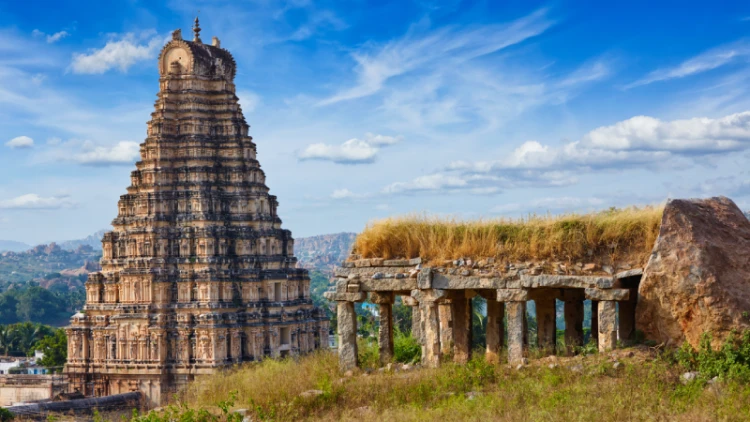Hampi, a UNESCO World Heritage Site in Karnataka, India, is synonymous with the grandeur of the Vijayanagara Empire. Once the capital of one of the most powerful empires in Indian history, Hampi is a living testament to the empire’s architectural brilliance, cultural richness, and historical significance. In this guide, we’ll delve deep into Hampi’s connection to the Vijayanagara Empire, exploring its rise, golden age, and eventual decline, along with the legacy it left behind.
The Rise of the Vijayanagara Empire
The Vijayanagara Empire was founded in 1336 by two brothers, Harihara I and Bukka Raya I, under the guidance of their guru, Vidyaranya. The empire was established to resist the advancing Islamic Sultanates and to preserve Hindu culture and traditions.
- Founding of Hampi: Hampi was chosen as the capital due to its strategic location and natural defenses, surrounded by the Tungabhadra River and rocky hills.
- Early Expansion: The empire quickly expanded its territories, bringing much of South India under its control.
- Cultural Revival: The Vijayanagara Empire played a crucial role in reviving and preserving Hindu art, architecture, and traditions.
The Golden Age of the Vijayanagara Empire
The empire reached its zenith during the reign of Krishnadevaraya (1509–1529), often referred to as the “Golden Age” of the Vijayanagara Empire.
1. Architectural Marvels
Under Krishnadevaraya’s rule, Hampi witnessed the construction of some of its most iconic structures.
- Virupaksha Temple: Expanded and beautified during this period, the temple became a major religious and cultural center.
- Vittala Temple: Known for its stunning stone chariot and musical pillars, this temple is a masterpiece of Vijayanagara architecture.
- Lotus Mahal: A beautiful palace with a unique lotus-shaped dome, showcasing the empire’s architectural ingenuity.
2. Economic Prosperity
The empire’s economy thrived due to extensive trade and agriculture.
- Trade Routes: Hampi was a major trading hub, connecting South India with the rest of the world.
- Agricultural Wealth: The fertile lands around Hampi supported a thriving agricultural economy.
- Currency: The empire minted its own gold coins, known as “Varahas,” which were widely used in trade.
3. Cultural Flourishing
The Vijayanagara Empire was a patron of art, literature, and music.
- Literature: Renowned poets and scholars, such as Tenali Rama and Allasani Peddana, flourished under Krishnadevaraya’s patronage.
- Music and Dance: The empire promoted classical music and dance forms, which are still celebrated in Hampi today.
- Religious Tolerance: Despite being a Hindu empire, Vijayanagara was known for its religious tolerance, with Jain and Muslim communities coexisting peacefully.
The Decline of the Vijayanagara Empire
The empire’s decline began after the Battle of Talikota in 1565, where the combined forces of the Deccan Sultanates defeated the Vijayanagara army.
- Destruction of Hampi: The victorious armies looted and destroyed much of Hampi, leading to its eventual abandonment.
- Fragmentation: The empire fragmented into smaller states, losing its former glory.
- Rediscovery: Hampi remained in ruins until it was rediscovered by British archaeologists in the 19th century.
Hampi’s Legacy: A Living Testament to the Vijayanagara Empire
Despite its decline, the Vijayanagara Empire left an indelible mark on Indian history, and Hampi stands as a living testament to its legacy.
1. Architectural Influence
The architectural style of the Vijayanagara Empire influenced later South Indian temple architecture.
- Dravidian Style: The empire’s temples are prime examples of Dravidian architecture, characterized by towering gopurams, intricate carvings, and massive courtyards.
- Innovative Techniques: The use of granite and soapstone, along with innovative construction techniques, set new standards in architecture.
2. Cultural Impact
The empire’s cultural contributions continue to influence South Indian traditions.
- Literature and Music: The works of Vijayanagara-era poets and musicians are still celebrated today.
- Festivals: Many festivals, such as Hampi Utsav, have their roots in the Vijayanagara period.
3. Historical Significance
Hampi’s ruins provide valuable insights into the empire’s history and way of life.
- Archaeological Sites: The ruins of palaces, temples, and marketplaces offer a glimpse into the empire’s grandeur.
- UNESCO World Heritage Site: Hampi’s historical and cultural significance has earned it a place on the UNESCO World Heritage List.
Exploring Hampi’s Vijayanagara Heritage
1. Must-Visit Sites
- Virupaksha Temple: The oldest and most famous temple in Hampi.
- Vittala Temple: Known for its iconic stone chariot and musical pillars.
- Hazara Rama Temple: Famous for its bas-reliefs depicting scenes from the Ramayana.
- Royal Enclosure: The administrative and royal center of the empire, featuring the Lotus Mahal and Elephant Stables.
2. Guided Tours
- Heritage Walks: Join a guided heritage walk to learn about the history and significance of Hampi’s ruins.
- Archaeological Tours: Explore the archaeological sites with an expert guide.
3. Cultural Experiences
- Hampi Utsav: Participate in the annual festival celebrating the empire’s cultural heritage.
- Traditional Performances: Enjoy classical music and dance performances inspired by the Vijayanagara era.
Tips for Exploring Hampi’s Vijayanagara Heritage
- Hire a Guide: A knowledgeable guide can provide valuable insights into the history and significance of the sites.
- Wear Comfortable Shoes: Hampi’s ruins are spread over a large area, so wear comfortable shoes for walking.
- Stay Hydrated: Carry water and stay hydrated, especially if you’re exploring during the day.
- Respect the Ruins: Avoid touching or climbing on the ancient structures to preserve them for future generations.
How to Reach Hampi
Hampi is well-connected by road, rail, and air. The nearest railway station is Hospet Junction, which is about 13 km from Hampi. From there, you can hire a taxi or take a local bus to reach the town. The nearest airport is Vidyanagar Airport, which is approximately 40 km away.
Final Thoughts: A Journey Through Time
Hampi’s connection to the Vijayanagara Empire is a fascinating chapter in Indian history. From its rise as a powerful empire to its eventual decline, Hampi’s ruins tell the story of a glorious past that continues to inspire and captivate visitors. Whether you’re a history enthusiast, a culture lover, or an architecture buff, Hampi offers a journey through time that you’ll never forget.

